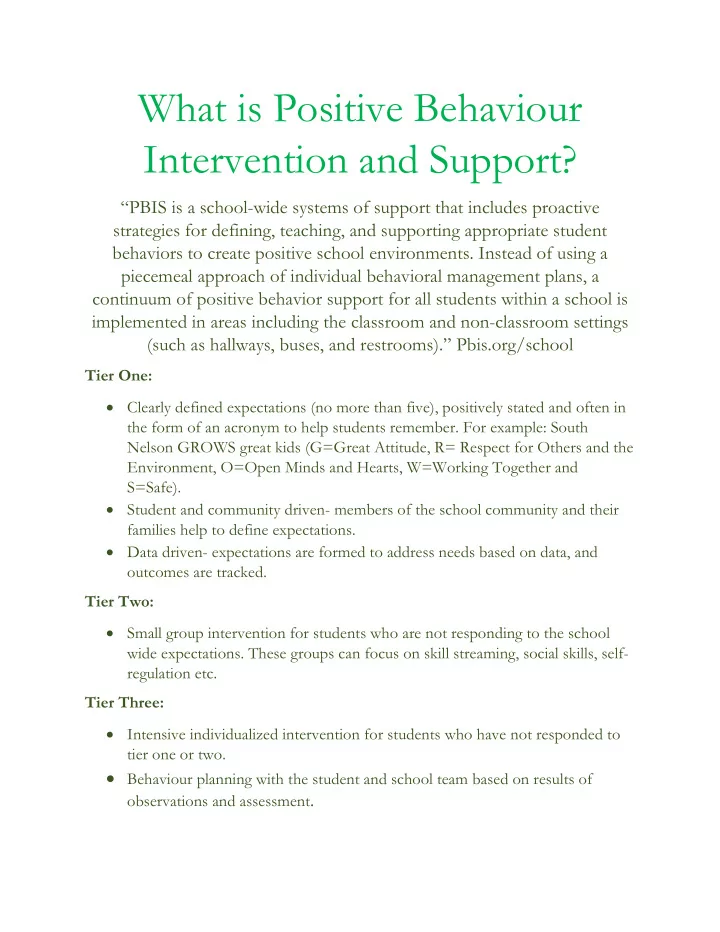

What is Positive Behaviour Intervention and Support? “PBIS is a school-wide systems of support that includes proactive strategies for defining, teaching, and supporting appropriate student behaviors to create positive school environments. Instead of using a piecemeal approach of individual behavioral management plans, a continuum of positive behavior support for all students within a school is implemented in areas including the classroom and non-classroom settings (such as hallways, buses, and restrooms).” Pbis.org/school Tier One: Clearly defined expectations (no more than five), positively stated and often in the form of an acronym to help students remember. For example: South Nelson GROWS great kids (G=Great Attitude, R= Respect for Others and the Environment, O=Open Minds and Hearts, W=Working Together and S=Safe). Student and community driven- members of the school community and their families help to define expectations. Data driven- expectations are formed to address needs based on data, and outcomes are tracked. Tier Two: Small group intervention for students who are not responding to the school wide expectations. These groups can focus on skill streaming, social skills, self- regulation etc. Tier Three: Intensive individualized intervention for students who have not responded to tier one or two. Behaviour planning with the student and school team based on results of observations and assessment .
TIER ONE PRIMARY INTERVENTION Clearly defined expectations that have been decided upon in a collaborative manner with the whole community Teach expectations to all students Monitor student progress to inform interventions Use data to make decisions HOW CAN COACHES HELP? Provide after-school or professional development workshops Attend staff meetings Collaborate on a road-map for implementation Assist with data collection
TIER TWO SECONDARY INTERVENTION Small group intervention to teach specific skills that will support the development of positive behaviour. Examples include: Self-regulation and social skills. HOW CAN COACHES AND THE STAFF AT STUDENT SERVICES HELP? Zones of Regulation workshops with District Integration Support Teacher, Sandy Boscariol and O.T.’s Cari Julien and Rachelle Vogel Incredible Flexible You program with the Speech and Language Pathologists Support implementing social skills groups using programs such as the PEERS or Social Thinking (Michelle Garcia Winner) Support analyzing data and deciding which students would benefit from small group interventions
TIER THREE TERTIARY INTERVENTION Individualized planning for students who need extra support Create a behaviour plan based on the findings of assessments and data HOW CAN COACHES AND THE STAFF AT STUDENT SERVICES HELP? Conduct Functional Behavioural Assessments or standardized assessments such as the BASC or Conner’s to assist in behaviour planning Assist in the implementation of individualized behaviour planning by supporting the school team in the creation of resources to support individual students Meet with staff to decide which students require more individualized planning
Example from a Nelson school: South Nelson GROWS great kids! G = Great Attitude R = Respect for others and our space O = Open minds and hearts W = Working together S = Safe
ALIGNMENT WITH DISTRICT GOALS Academic Success: Information from U.S. studies show a strong relationship between improvements in academic achievement and the implementation of school wide PBIS. “A study of 22 New Hampshire schools found that after only two years of implementation, 73% of PBS schools had increased math scores on standardized tests. The schools also significantly lowered suspensions and office discipline referrals, allowing schools to recover hundreds of days of instructional time that had previously been lost to behavioral disruptions.” (www.bazelon.org) “A district ‐ wide study of Lane County (Oregon) elementary and middle schools compared those that had implemented school ‐ wide PBS to those that had not. The PBS schools had higher standardized test scores than the others. This finding was all the more impressive since the PBS schools began with lower scores.” (www.bazelon.org) Resiliency: PBIS encourages and trains school staff to more effectively meet the social/emotional needs of all students which promotes the protective factors associated with resilience . Citizenship: PBIS teaches all students positive behaviours that will help them become contributing members of the community.
ALIGNMENT WITH THE REVISED B.C. CURRICULUM PBIS fits well with the core competencies of the revised B.C. curriculum: COMMUNICATION Individualized and group instruction in communication and social skills is a part of teaching positive behaviour. POSITIVE PERSONAL AND CULTURAL IDENTITY PBIS encourages community involvement in the development of school-wide expectations. These expectations should reflect the cultural identity of the students and their families. Many B.C. schools have integrated First Nations artwork, symbols and beliefs into their PBIS program. PERSONAL AWARENESS AND RESPONSIBILITY PBIS engages students in the creation of expectations and leads to a high level of ownership. The students develop a sense of responsibility for the culture of their school and awareness of their own contributions. SOCIAL RESPONSIBILITY PBIS encourages social responsibility in all aspects of school life. It gives students a reference to guide their behaviour and actions in their relationships with others and how they conduct themselves in different environments.
Recommend
More recommend